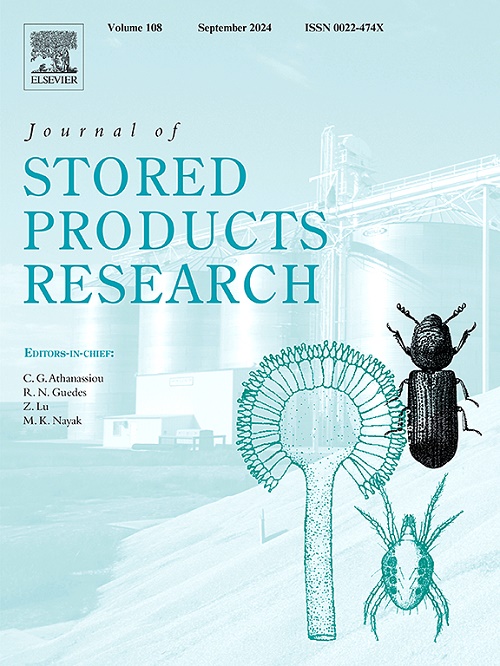co2改性环境对红粉甲虫生理和肠道菌群的剂量依赖性影响
IF 2.7
2区 农林科学
Q1 ENTOMOLOGY
引用次数: 0
摘要
二氧化碳改性气调贮藏是一种防治储粮害虫的生态友好策略。然而,昆虫对不同CO2浓度反应的分子和微生物机制仍然知之甚少。本研究研究了暴露于不同CO2浓度(35%和60% CO2)下的三角虫(Tribolium castaneum)的生理、转录组学和肠道微生物群的反应。转录组学分析结合酶促分析表明,35%的CO2主要激活了参与消化和NADPH产生的基因,如DHDH上调2.77倍。相比之下,60% CO2显著上调GST(1.52倍)和胰腺分泌基因,CTRL(2.63倍),CTRB(1.46倍)和CPA2(2.65倍),并提高胰蛋白酶(1.96倍),脂肪酶(2.86倍)和GST(3.58倍)活性。微生物分析表明,35%的CO2有利于假单胞菌,而60%的CO2有利于芽孢杆菌。功能预测表明,微生物在35% CO2条件下对宿主信号转导有贡献,在60% CO2条件下对胁迫缓解有贡献。关键属,如肠球菌和假单胞菌,表现出与宿主基因表达和酶活性的特异性相关性,表明微生物群可能介导宿主应激反应的调节。这些研究结果为揭示玉米霉在CO2-MAs环境下的剂量依赖性生理适应提供了新的见解,并突出了宿主转录重编程与肠道微生物可塑性之间的相互作用。本文章由计算机程序翻译,如有差异,请以英文原文为准。

Dose-dependent effects of CO2-modified atmospheres on physiology and gut microbiota of red flour beetle
CO2-modified atmosphere storage is an eco-friendly strategy for controlling stored grain pests. However, the molecular and microbial mechanisms of insect responses to different CO2 concentrations remain poorly understood. This study investigated the physiological, transcriptomic, and gut microbiota responses of Tribolium castaneum exposed to different CO2 concentrations (35 % and 60 % CO2). Transcriptomic profiling combined with enzymatic analysis revealed that 35 % CO2 primarily activated genes involved in digestion and NADPH generation, such as DHDH upregulated 2.77-fold. In contrast, 60 % CO2 markedly upregulated GST (1.52-fold) and pancreatic secretion genes, CTRL (2.63-fold), CTRB (1.46-fold), and CPA2 (2.65-fold), as well as elevated in trypsin (1.96-fold), lipase (2.86-fold), and GST (3.58-fold) activities. Microbial profiling demonstrated that 35 % CO2 enriched Pseudomonadota, whereas 60 % CO2 favored Bacillota. Functional prediction suggested microbial contributions to host signal transduction under 35 % CO2 and stress mitigation under 60 % CO2. Key genera, such as Enterococcus and Pseudomonas exhibited treatment-specific correlations with host gene expression and enzyme activity, suggesting a potential microbiota-mediated modulation of host stress responses. These findings provided new insights into the dose-dependent physiological adaptations of T. castaneum under CO2-MAs and highlighted the interaction between host transcriptional reprogramming and gut microbial plasticity.
求助全文
通过发布文献求助,成功后即可免费获取论文全文。
去求助
来源期刊
CiteScore
5.70
自引率
18.50%
发文量
112
审稿时长
45 days
期刊介绍:
The Journal of Stored Products Research provides an international medium for the publication of both reviews and original results from laboratory and field studies on the preservation and safety of stored products, notably food stocks, covering storage-related problems from the producer through the supply chain to the consumer. Stored products are characterised by having relatively low moisture content and include raw and semi-processed foods, animal feedstuffs, and a range of other durable items, including materials such as clothing or museum artefacts.

 求助内容:
求助内容: 应助结果提醒方式:
应助结果提醒方式:


